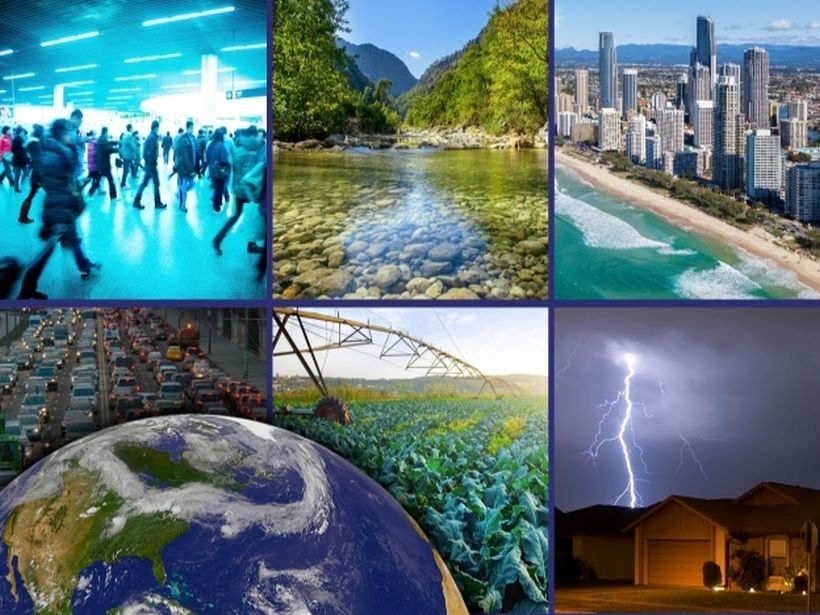Two recent papers in Earth’s Future examine the meaning and formalization of an Anthropocene Epoch, a geological era in which humans have a major impact on surface processes and the environment. Steffen et al. [2016] take an Earth systems approach while Williams et al. [2016] focus on biospheric signals. Both papers are informative and data-based and should become required reading for anyone interested in the proposed change to Earth’s geologic timescale and, especially, modern global change. The field of stratigraphy is explicitly recognized in each analysis, as it provides the foundation of the Geologic Timescale.
A quick primer on stratigraphy: for the past 2.5 million years, we have lived in the Cenozoic Era’s Quaternary Period, which started with the Pleistocene Epoch and, currently, the Holocene Epoch. The addition of an Anthropocene Epoch into the geological time scale is a key motivation behind these papers, which will be decided by the International Commission on Stratigraphy, supported by an Anthropocene Working Group that includes the leads and several authors of these two papers.
Steffen and colleagues use Earth systems science to describe our planet’s evolution from an evolving Precambrian environment into a life-dominated Phanerozoic one (since ~540Ma). They conclude that today’s Earth system has undergone a substantial transition away from the Holocene (interglacial) state, toward a world with much less polar ice, changed atmospheric composition, and accelerated plant and animal species extinction. Williams and colleagues’ biotic approach emphasizes that modern humans are changing our relationship with the planet through human consumption of Earth’s resources, with major consequences for the ecosphere and a change in evolutionary state. Using different perspectives, both papers reach the same conclusion of an Anthropocene state that is unlike the Holocene, supporting the need for a new epoch. Both also favor a chemical tracer from mid-20thC nuclear activity as its lower timescale boundary, though that seems less compelling from their descriptions.
The stratigraphic foundation of the Phanerozoic Eon’s geologic timescale is the preservation of hard-bodied life. Extinctions, a relatively sudden, large decline of species, punctuate the record with five major events (excluding today) and multiple smaller events, providing global markers for stratigraphic boundaries in the geologic record. Some extinctions were relatively fast (thousands of years), while others reflect longer times (millions of years). The species extinction of modern time, which started with the rise of humans as the planet’s dominant consumer of resources can likewise become the base of the Anthropocene. This latest (6th) major extinction is already underway, and continuing for decades to centuries, perhaps even culminating in human extinction. Life, notably the radiation of species, offers another global stratigraphic marker in the tradition of the geologic timescale. Humans exploring and conquering the world transported other life, including plants and seeds, small animals (like insects and rodents), and even large animals (like horses) that since became entrained as fossils in modern depositional strata. This biomarker would place the start of the Anthropocene well before the 20th century, as far back as 15th century, following Medieval times. Arguably, the current 6th extinction also started around that time. Unlike the Holocene, which started ~12,000 years ago as a garden-variety interglacial, the Anthropocene involves vast and fast changes on a global scale, involving life, atmosphere, land, and oceans. This pattern is not a mere extension or acceleration of the Holocene interglacial. The Anthropocene signature is unlike that of our planet’s icehouse-greenhouse system, leading to my earlier suggestion in van der Pluijm [2014] to adopt a Pleistocene-Anthropocene boundary that reflects this fundamental change in Earth system from an externally-driven Milankovitch state to a human-driven state. As we move toward a decision, these authors contribute to the compelling case for an Anthropocene Epoch, while reminding us of the environmental state change that is underway.
—Ben van der Pluijm, Editor-in-Chief, Earth’s Future (email: [email protected])
[Related content: For more information, please see the Eos News story and Editors’ Vox on the work of the Anthropocene Working Group.]
Citation:
van der Pluijm, B. (2016), Here comes the Anthropocene, Eos, 97, https://doi.org/10.1029/2018EO058059. Published on 07 September 2016.
Text © 2016. The authors. CC BY-NC-ND 3.0
Except where otherwise noted, images are subject to copyright. Any reuse without express permission from the copyright owner is prohibited.

